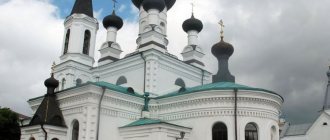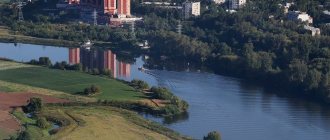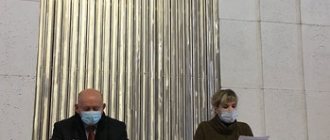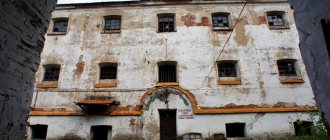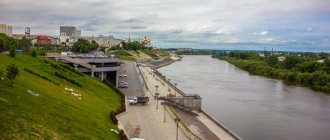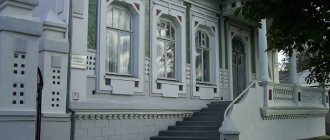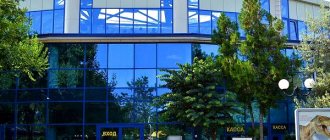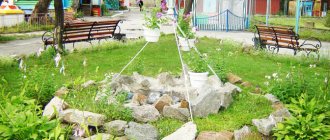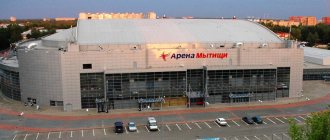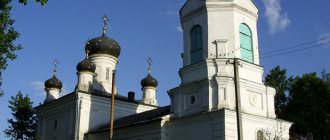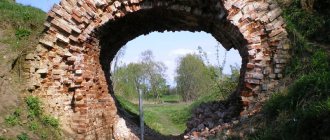Ice arena and monument to the founder of hockey
You can get to the ice arena on Mendeleev Street. This is the home arena of the local hockey team Khimik Voskresensk and can accommodate four thousand spectators.
You can get to the match for only 100 rubles; the most expensive ticket in the VIP zone costs 500 rubles. The first match was played here back in 1966, then the current coach scored one goal against Khimik, the match ended with a draw. The structure was built according to a standard design; similar arenas exist in other Russian cities, for example Elektrostal, Cherepovets, Samara and other centers.
The whole history, as well as which titled athletes the city of Voskresensk gave, can be read on the official website of the sports institution
https://www.voskrhimik.ru/arena/
On the square in front of the ice palace there is a sculpture dedicated to the founders of the Khimik hockey team. The monument was erected in 2008; these are three figures of people who did a lot for local hockey, the first coach of the team, and the managers of the chemical plant. The team dates back to 1953 and played in the top division of the KHL.
Don't forget to subscribe to my YouTube channel Aviamania)
Monuments and monuments of the city of Voskresensk
There are also memorable places in Voskresensk that, through simple sculptural sculptures, can show excerpts from the history of the city.
Sculpture "Resurrection of Christ"
- Address: 50th anniversary of Lenin Komsomol boulevard.
The monument can safely be included among the main monuments of Voskresensk. The figure of Christ the Savior, towering above the gates of heaven, is surrounded by two angels. Composition by sculptor A.M. Taratynova was installed in 2008. It refers to the biblical story that gave its name to the temple, and after it to the entire city.
Monument to the founders of Resurrection hockey
- Address: st. Mendeleeva, 2.
The sculptural composition installed near the ice arena refers to the origins of the city's sporting glory. It is called the “monument to the three Nicholas”. The first coach of the Khimik team, Nikolai Epshtein, is depicted in local hockey, the directors of the chemical plant - Doktorov and Khripunov.
Monument to Nikolai Doktorov
- Address: st. Doctorova, 4.
The seventh director of the Voskresensky Chemical Plant, N. Doktorov, who became a legendary figure for the city, was also awarded a personal monument. He headed the plant for more than 30 years and made a huge contribution to the development of Voskresensk. A bronze bust of a famous city dweller by Valeria Dorokhova appeared in 2008.
Eternal flame
- Address: Pionerskaya st., 11.
Memorials to soldiers who died in the Great Patriotic War have been erected in many localities in Russia. The Resurrection Eternal Flame was lit in 1975; the source of the “sacred flame” was a torch delivered from the hero city of Brest. The obelisk to the fallen is laconic and strict, but nevertheless attracts attention. For the 70th anniversary of the victory, the complex was supplemented with slabs with the names of heroes native to Voskresensk.
Absetzers (giant excavators)
Voskresensk
Huge monstrous excavators, the size of a multi-story building, have been working at the Lopatinsky mine since the 1960s. Now almost all of them are cut into scrap metal (the mine was abandoned in the 90s). Two examples remain in relatively working condition in 2022: the TAKRAF ERs 710 multi-bucket eight-track excavator manufactured in the GDR and the NKMZ walking excavator made at the Novokramatorsky Machine-Building Plant. After the mine closes, they ship quarry sand here for the glass industry. A train with a diesel locomotive “cuckoo” periodically comes for sand.
These colossal monuments to the industrialization of the Voskresensky district attract many curious tourists, who are not deterred by the fact that they have to make their way to the monsters along poor-quality dirt roads.
In the foreground is a multi-bucket excavator, behind it is a walking one.
The Lopatinsky mine was the largest deposit of phosphorites in Europe - minerals used as fertilizers. Development has been carried out since 1932, using open-pit methods. Gigantic excavators weighing about 2 thousand tons were distinguished by enormous productivity. They ran on electricity, since diesel fuel would have been needed too much.
After the development of the field stopped in the “roaring nineties”, the quarries were quickly flooded with groundwater. Therefore, dozens of deep lakes with sandy shores and clean water were formed in the Voskresensky region. They are not on the map, but they are visible even in photographs from space.
These lakes-flooded quarries alternate here with strange sandy deserts - with dark, white and red dunes covered with pine trees. Many amazing, unearthly landscapes also attract tourists to this unique natural-technogenic reserve - after all, such photo sessions cannot be found anywhere else.
Location: Voskresensky district, abandoned Lopatinsky mine.
Felt Factory History Museum
Yuryev-polsky attractions
This exhibition institution is associated with the name of local entrepreneur Kapetsov, who in the century before last founded the first dyeing workshop on the site of today’s city center.
A little later in 1880, the son of a businessman built a two-story stone factory in what was then called the village of Lopatin. The building successfully survived all the hardships, it was not only preserved, but production operates there to this day.
The museum exhibits tell about the entire history of production, which has been going on for 130 years. For the first time it opened its doors to visitors in 1971. One of the exhibitions was dedicated to the Great Patriotic War. After the change of owners at the felt factory, the museum became unnecessary.
Now some of his exhibits can be seen at local secondary school No. 9. The rest of the exhibition is located on Bykovskogo Street, under the same roof as the company’s company store, so you can combine a visit to the museum with shopping.
You can read about the history of the factory here
https://fetr.org/articles/istoriya_fabriki_fetr/
There are a couple more locations that are worth mentioning in the review, Voskresensk attractions, a local mountain and a lake, but first things first.
Voskresensk: temples and monasteries of the city
There are many various Orthodox shrines within the city and its surroundings - temples and churches, monasteries and monasteries, chapels and parishes. The main ones are discussed in this section of the material.
Novo-Solovetskaya Marchugovskaya men's hermitage
- Address: Staraya st., 57, Faustovo village.
The phrase “Solovetsky Monastery” evokes associations with the famous monument of the Russian North - a monastery lost on islands in the White Sea between the Arkhangelsk region and Karelia . However, in the Moscow region, in the village of Faustovo, not far from Voskresensk, this famous monastery complex has a working courtyard, or, in modern terms, a branch.
Officially, the Novo-Solovetsky Marchugovskaya Hermitage was founded in 1654, but historical documents contain references to the existence of a monastic settlement in these places at the end of the 15th century.
The main temple of the monastery is the Ascension Cathedral, an architectural monument of the “Naryshkin Baroque”. In total, there are three active churches on the territory of the monastery. They were all built in the second half of the 17th century and are interesting not only as functioning Orthodox religious sites, but also as magnificent examples of different architectural styles, combined into one ensemble.
Church of John Chrysostom
- Address: Novlyanskaya st., 14, Novlyansky microdistrict.
On Novlyanskaya Street in Voskresensk there is a temple of the late 18th century, built in the provincial Baroque style.
The Church of St. John Chrysostom attracts with its festive decoration; the façade is decorated with figurines of saints. In the 19th century it was reconstructed. There is a version that the famous architect O.I. had a hand in this reconstruction. Beauvais.
In the early Soviet period, parishioners defended the church, preventing it from being destroyed and looted. Already in 1946, after a short period of oblivion, it again opened its doors to believers and is still active.
Near the church there is a small chapel containing the relics of the locally revered Saint Nila. This nun was among those repressed by the Soviet regime.
Church of the Archangel Michael
- Address: village of Karpovo.
The church, modest in appearance, but distinguished by its elegance and special provincial charm, is the work of the architect N. Markov. Date of construction: 1884. Previously, there was a wooden church on this site. The modern temple was built using donations.
The names of everyone thanks to whom this Orthodox site appeared in the city are listed on a memorial plaque installed at the entrance to the church. In its entire history it has never been closed. The main shrine belonging to the temple is the icon of the Kazan Mother of God.
Church of St. Sergius of Radonezh
- Address: Lopatinsky microdistrict, Pervomaiskaya st., 29.
The wooden church in Voskresensk, consecrated in honor of St. Sergius, is not an ancient architectural monument. The temple was built in the 2000s. in memory of the soldiers of the Great Patriotic War who died at the fronts.
Despite its young age, the church has important shrines. Pieces of the relics of St. Sergius of Radonezh were transferred here. Part of the mantle of Seraphim of Sarov is also kept here.
Church of the Tikhvin Icon of the Mother of God
- Address: pos. them. Tsyurupa.
The Church of the Tikhvin Icon of the Mother of God has an ancient history. It is believed that it appeared here around the 16th century. The shrine took on its modern appearance in 1885-1899. Created by architects P.P. Zykov and N.D. Strukov. The first is the author of the tented church in the pseudo-Russian style, and the second is the author of the refectory, attached to the church in the last year of the 19th century.
Church of Cosmas and Damian
- Address: s. Vinogradovo.
Several interesting churches can be seen in the village of Vinogradovo near Voskresensk. In the mid-19th century, a wealthy peasant family financed the construction of a parish here. The temple, consecrated in honor of the unmercenary saints, combines the features of the Empire and Baroque architectural styles.
Church of St. John the Evangelist
- Address: Vinogradovo village.
At the very end of the 19th century, a church was erected in Vinogradovo in the pseudo-Russian style by the architect Vyacheslav Frantsevich Zhigardlovich, the author of many civil and religious buildings in Moscow and the Moscow region. The construction of the temple, consecrated in honor of John the Theologian, was financed by the wealthy merchant Saltykov. It is dedicated to the memory of the 1888 train accident in Kharkov, in which the imperial family miraculously survived. This miraculous salvation was perceived by the religious creation of the autocrat's subjects as a divine accomplishment.
Pedestrian bridge over the Moscow River
Sights of Pushkin, St. Petersburg (Tsarskoe Selo attractions)
The Moscow River divides the city of Voskresensk into two parts. In 1977, a pedestrian bridge connecting the central part of the city with the Novlyansky district was put into operation. built in 1977. Before this, since the 1930s, a pontoon bridge was built across the Moscow River in Voskresensk. The Capital Pedestrian Bridge is an excellent route for walking in the city. The bridge offers beautiful panoramic views: views of temples, the Krivyakino estate and the park.
Pedestrian bridge over the Moscow River.
Location: Voskresensk, Novlyansky pedestrian bridge.
In general, modern Voskresensk makes a favorable impression of a well-groomed, cozy, prosperous city. Of all the cities in the Moscow region, it is one of the most green, and there is relatively inexpensive real estate here. In the vicinity of the city there is a real forest, and on the clean lakes there are many excellent places for recreation and wonderful sandy beaches. The unfavorable environmental situation is a thing of the past: local enterprises are operating at a negligible fraction of their production capacity. Therefore, a considerable part of the working population works in Moscow (2 hours by train to Kazansky station).
Main attractions: what to see, where to go as a tourist
I would recommend coming to the city for the whole weekend in order to have time to get acquainted with the main attractions of Voskresensk, since it will be difficult to do this in one day. Here you can walk through places with a rich history and take a break from the bustle of big cities.
Church of the Resurrection
The first mention of the church in the Scribe books dates back to 1557.
At first, this temple was built of wood, but this design did not last long: at the end of the 19th - beginning of the 20th centuries. A stone cathedral was built here.
However, after the Civil War, the temple was closed and destroyed, and the rector was shot. The dilapidated church building began to be restored at the end of the 20th - beginning of the 21st centuries. Now this architectural monument has been restored and welcomes visitors and citizens.
Jerusalem Temple
Previously, the city square of the Soviets was located on the site of the temple.
Earlier, during the times of the USSR, on the site of this temple there was the Square of the Soviets. Rallies, marches and demonstrations were held here. However, in 2006, construction of the church was completed. The temple attracts visitors to the city with its architecture and infrastructure, which is quite developed. On the church grounds there is a museum of shooters, where you can not only look at weapons and uniforms, but also try them on, touch various household items, try to cast bullets, load a arquebus, etc.
There is a school of bell-ringers at the temple, where you can learn to ring bells and try to compose music yourself.
Krivyakino Estate
The estate is the cultural center of the city of Voskresensk.
This building was erected in the 18th century. Now it houses a cultural center. I. I. Lazhechnikov, the founder of the historical novel in Russia, spent his childhood here.
You will also like: Karachay-Cherkess Republic attractions: to visit by car, the most beautiful places, where to go and where to relax
On the plot there is a church and other attractions. Tours are held here daily.
Achkasovo Estate
The Achkasovo estate is included in the list of architectural and historical complexes in the Moscow region.
This building also dates back to the 18th century, and on the plot of land a church (Nikolskaya) was erected, dedicated to the liberation from Napoleon’s invasion. Its construction lasted 3 years.
At the end of the 90s. XX century The church was restored by parishioners at their own expense. Adjacent to the building is a bell tower consisting of 2 tiers.
Now restoration work has been resumed here, since not all buildings have survived to this day.
Church of the Archangel Michael
In 2022, the Church of St. Michael the Archangel in the village of Karpovo turned 135 years old.
This church was designed and built by the architect N. M. Markov. Previously, there was a wooden church here, dating back to 1884. Funds for the new building were collected by parishioners and townspeople.
A two-tier bell tower is attached to the church. Within the walls of this sanctuary are collected various icons and shrines that have been preserved since the time of its first construction. Since its opening, the church has never been reconstructed.
Church of St. John the Evangelist
Built in 1761, the church is the main city temple.
The church was erected in 1891 according to the idea of the architect V.F. Zhigardlovich in honor of the rescue of the emperor’s family during a train crash on the Southern Railway. Funds for its construction were provided by the merchant I. A. Saltykov.
The tragedy happened in 1888: the train in which the royal family was traveling went off track and overturned near the Spasov Skit station near Kharkov. Dozens of people died during the crash, but none of the emperor’s family, including Alexander II himself, was killed or injured. The incident was hailed as a miracle, and after this, temples began to be built throughout the Russian Empire.
Eternal flame
The eternal flame in the square was lit from the fire that was brought from the Brest Fortress.
This memorial complex was opened in 1975 on the thirtieth anniversary of the victory in World War II. The eternal flame was lit from the Brest torch. The territory of the complex is constantly expanding. Its main attractions are the obelisk and tombstones, on which are engraved the names of heroes of the USSR and Knights of the Order of Glory.
On memorial days, various demonstrations, rallies, and other festive events for city residents are held here.
Solovetskaya Marchugovskaya hermitage
The Solovetsky Marchugovskaya hermitage is located on the bank of the river, near the village of Faustovo.
The first monastic settlements appeared near Voskresensk back in the 15th century. The desert itself was formed in 1654 after a plague epidemic that claimed many lives. In honor of deliverance from this misfortune, Patriarch Nikon blessed the foundation of the Solovetsky Marchugov Hermitage.
You will also like: What a tourist should definitely see in Istra
However, the temple, built of wood, could not withstand the flood, and the hermits were moved to Red Hill, where they began to build a stone sanctuary.
There are 3 temples in the desert, erected in the 15th century.
Spasskoye Estate
The estate is included in the list of cultural heritage of the Moscow region.
This architectural structure was erected on the banks of the Moscow River at the end of the 18th century. The construction was initiated by the Tolstoy family. The entire estate and the surrounding area are considered architectural monuments of romanticism. Here N.V. Gogol wrote his 2nd volume of the novel “Dead Souls”.
For a long time the estate was abandoned and dilapidated. Only in 2014 did they decide to restore it, restore the park complex, and make this place a tourist attraction.
Pedestrian bridge over the Moscow River
In 2013, architectural lighting of the pedestrian bridge was completed.
The river flowing in this area divides the city into 2 districts:
- Novlyansky;
- Central.
They are connected by a pedestrian bridge built at the end of the 20th century. In the 20s there was a pontoon here. But the settlement grew rapidly, new residential areas were built and factories were opened. There were more and more residents, and there was a need to build a new bridge. Nowadays walking tours are conducted along it: the beautiful landscape of the surrounding areas attracts both tourists and townspeople.
City Day program from June 10 and 11, 2018 in Voskresensk
City Day June 10 Central platform on Lenin Square in Voskresensk
11.00 Large-scale festive procession of enterprises and organizations of the city “City of the Future!”
12.00 Grand opening of the holiday. Theatrical composition “Locomotive of History”.
Official part of City Day.
Congratulations to the guests. Honoring Honorary Citizens, peers of the city. Awarding the golden anniversaries and newlyweds of Voskresensk. Concert program “City Born in the USSR” End of the official part
City Park from 14 to 19 Thematic areas:
Summing up the “Resurrection Muses” competition. Venue for theatrical performances. Award ceremony summing up the results of the competition “Fashion from the people” and “How it was…” (Songs and dances of the 30s). Exhibition of folk art of Voskresensk residents “Voskresensk - City of Masters”, master classes, performances by creative groups. Ceremonial awarding of the winners and participants of the competition. Photo competition (drying) “My dear Voskresensk.” Television competition of readers “Reading Voskresensk”. Science show from Professor Booms. Big chess tournament "Chess Planet". Horseback riding. Shopping arcades and book fair. Theatrical excursions in the city park. An entertainment program with the participation of the municipal life-size puppet theater “Sofit”, a concert of children’s creative amateur art groups of the city “All the small stars for you, Voskresensk”.
Awards summing up the results of the competitions:
- children's creative works “My Small Motherland”;
- “City of the Future” and showing video clips about Voskresensk;
- “Fairy tale, I know you!” or “KARAPOOZ CARNIVAL!” and a retro costume for adults “Grandma’s Chest”.
- The central platform on Lenin Square. Evening
19.00 Big festive concert of creative groups of the city and region “Vivat Voskresensk!”
21.00 Concert program of Russian pop stars Anastasia Stotskaya and the group “MBAND”.
23.00 Festive fireworks.
Voskresensk City Day June 11
The area in front of the Dolphin engine. Street dance festival. There are sports and gaming complexes “Climbing Wall”, “Gladiator”, “Accurate Goal”, “Log of Strength”.
Stadium SC "Khimik"
9.00 Athletics run “Voskresenskaya Versta”
12.00 Moscow region football championship among children's and youth teams.
15.00 Voskresensky district football cup among youth teams.
17.00 Voskresensky district football cup among men's teams.
City Park 14.00 - 19.00 Resurrection Disneyland, show of stilt walkers, jugglers, animators, unicyclist acrobats, living statues.
Festival of author's song "Resurrection Dawn".
Concert of children's creative amateur art groups of the city “All small stars for you, Voskresensk”, games, competitions, entertainment.
Performance by youth rock groups of Voskresensk.
Floodplain of the Moscow River
19.00 Festive concert for youth
Ensemble "Maestro Jazz" under the direction of People's Artist of Russia Alexei Kuznetsov. Duet "Fusion" Stupino. Polina Medvedeva and the rock group “Medvedeva Vand”. Honored Artist of Russia Olga Kormukhina. Motorcycle club "Night Wolves" with a program of "Fire Drummers" and shooting motorcyclists.
23.00 Fireworks on the water surface of the Moscow River.
Where to go with a child in Voskresensk. Entertainment
Both adults and elderly people, as well as very young wanderlust lovers, as well as kids, can have fun in Voskresensk.
City amusement park
- GPS coordinates: 55.319889, 38.672482.
Voskresensk can boast of what reviews say is a fairly good amusement park, where townspeople go on weekends. Despite the rather weak infrastructure, it has several attractions (tickets are, however, a little expensive), but visitors are pleased with the pocket of natural beauty in the industrial center.
Ice Sports Palace "Moscow Region"
- Address: st. Mendeleeva, 2.
Voskresensk is the capital of hockey near Moscow. The local team “Khimik” brought sports glory to the city. This hockey club has raised several Olympic champions in one of the “most Russian” sports. The team, as one can logically assume from its name, belonged to a chemical plant. The ice palace, the club’s home arena, was built through the efforts of the most famous director of the enterprise, Nikolai Doktorov.
Today “Podmoskovye” is at the same time an important object from a historical point of view, an active hockey arena, and a place for recreation for citizens and tourists. Not only hockey players, but also figure skaters train in the palace; ice shows, concerts, and festivals are held here. There is a gym in the building of the sports complex, and there are several catering outlets. The skating rink in Voskresensk is a great place for lovers of active recreation.
The sports infrastructure of modern Voskresensk is well developed. In addition to the Sports Palace, there are many other sports facilities. In the vicinity of the city there are ski clubs, and equestrian sports are developing.
Blue Lake
- Coordinates: 55.442112, 38.537483.
Another consequence of the industrial use of the territory near Voskresensk over time turned into a picturesque place for relaxation and contemplation of beauty. “Blue Lake” is the name given to a quarry formed as a result of the extraction of ore for chemical production. The man-made reservoir is surrounded by beautiful forests. The views here are simply amazing. Those who like to relax and be alone with nature should definitely visit Blue Lake when they find themselves in Voskresensk.
Life-size puppet theater "Sofit"
- Address: Lopatinsky microdistrict, st. Andres, 1B.
Tourists who prefer cultural leisure to sports and outdoor recreation should go to the interesting local life-size puppet theater “Sofit”. The history of this institution goes back more than 30 years.
It all started with an amateur troupe, and today it is one of the cultural symbols of the city. Homemade dolls. They are produced in workshops organized at the theater.
The Sofita troupe and the dolls they make are regular participants in major city events. The repertoire is varied. The performances will delight both children and adults, allowing them to remember their childhood and feel the atmosphere of a fairy tale.
Novlyansky pedestrian bridge
- Coordinates: 55.318040, 38.665358.
In the Voskresensk area, the Novlyansky pedestrian bridge spans the Moskva River, which offers passers-by simply amazing views of the surrounding landscapes. They say that especially memorable photos are taken here at sunrise and sunset, however, even on a winter or summer day, a walk along the bridge will definitely be memorable. Of course, what could be better than a walk away from roads and exhaust fumes, in peace and quiet, in solitude with Mother Nature.
We also bring to your attention guides to other cities in the Moscow region:
- Klin, Balashikha, Zelenograd,
- Podolsk, Bronnitsy, Stupino,
- Krasnogorsk, Korolev, Lobnya,
- Serpukhov, Yegoryevsk, Zhukovsky,
- Pushkino, Dolgoprudny,
- Khimki, Dmitrov, Lyubertsy, Taldom,
- Shchelkovo, Noginsk, Domodedovo,
- Naro-Fominsk, Odintsovo, Reutov,
- Chekhov, Kolomna, Ramenskoye,
- Volokolamsk, Vereya, Elektrostal,
- Zaraysk, Sergiev Posad.
This is what the city of Voskresensk is like: typical and unique, ancient and modern, sporty and industrial. Historical, cultural and religious attractions familiar to tourists coexist here with unique and unusual objects.
Spasskoye Estate
Another magnificent estate on the banks of the Moscow River was founded by the Tolstoy family at the end of the 18th century. The estate was finally completed and acquired its completed appearance only in 1872. The buildings of the Spasskoye estate, as well as the surrounding garden and park area, are monuments of architectural romanticism. In one of the outbuildings, Nikolai Gogol wrote the second volume of Dead Souls.
Spasskoye Estate.
Until recently, the estate was in a very neglected, dilapidated state. However, in 2014, it was included in the governor’s program for the restoration of old architectural monuments, and restoration work is underway here. It is planned to restore the original appearance of the estate, with a garden and park complex, and develop tourism infrastructure here.
Location: Voskresensky district, Marishkino village, st. Spasskaya.
About the history of the city
The village, located on the site of the current city of Voskresensk, was first mentioned in the spiritual charter of Prince Ivan Kalita (1339). The name “Voskresenskoye village” first appears in the scribe books of 1577–1578. It came from the local Church of the Resurrection of Christ. This name stuck for centuries: in 1862, the village of the Voskresensk railway station built here was founded.
In 1934, the Soviet government formed the working village of Voskresensk, including a number of settlements: Neverovo, Krivyakino, as well as the territories of the Chemical Combine and the Brick Factory being built here. On July 14, 1938, this village already received city status. Subsequently, the city of Voskresensk, growing, absorbed nearby towns and villages: Kolyberovo, Lopatinsky, Marishkino, Trofimovo, Khlopki, Chemodurovo.
The city-forming enterprise of Voskresensk is the Chemical Plant, now JSC Voskresensk Mineral Fertilizers - a plant for the production of phosphorus-containing fertilizers, feed additives, phosphoric and sulfuric acids. He laid the foundation for the city of Voskresensk itself; gave work, determined the vocation and destiny of thousands of people, not only from the Moscow region, but also from other regions of the USSR. This enterprise continues to operate, although, of course, it no longer produces the same volumes of products.
One of the industrial zones of Voskresensk.
In addition, the city has a developed production of construction and finishing materials: there are brick and cement factories; Volgograd enterprise for the production of plasterboard, dry mixes, tile adhesive; factory producing German wallpaper "Erismann". The Voskresensk Felt Factory (now JSC “Fetr”) has a rich history and glorious traditions.
As a result of its industrial development, the city received a complex and heterogeneous planning structure. It consists of seven fairly separate districts (they are separated by industrial zones, transport pipelines and tributaries of the Moscow River).
Travel to the Voskresensky district: Pozharsky’s birthplace and Gogol’s place of inspiration
Material prepared by Voskresensky IA>>
Voskresensky district of the Moscow region is a land with a rich history. The first mentions of these places, according to the spiritual charter of Ivan Kalita, date back to 1339. The ancient name of the regional center - Voskresensk - has stood the test of time, surviving even the anti-religious Soviet era, and has survived to this day. On the territory of the region, many places associated with the most famous names of Russian literature and history have been preserved: Pozharsky, Gogol, Lazhechnikov. A correspondent for the Voskresensk news agency has compiled an interesting route through the estates and churches of the region.
The village of Voskresenskoye, which gave its name to the railway station and station village, and later to the city, was first mentioned in the scribe books of 1577-1578. The village got its name from the Church of the Resurrection of Christ. In 1934, by decision of the All-Russian Central Executive Committee, the workers' village of Voskresensk was formed, which already received the status of a city in 1938.
Collect the “Symbol of the Moscow Region.” Start the game>>
The estate of Prince Pozharsky
The coat of arms of the Voskresensky district depicts a golden shield, which is associated with the name of Prince Dmitry Pozharsky, the liberator of Moscow from the Polish-Lithuanian troops, whose monument is erected on Red Square in Moscow.
The village of Marchugi once belonged to the great-grandfather of the historically famous Prince Dmitry Pozharsky, Ivan Beklemishev, who was a diplomat and statesman during the reigns of Ivan III and Vasily III. In the winter of 1525, Ivan “Bersen” Beklemishev was executed, the village was requisitioned and became a palace. The mother of the future national hero, Princess Maria Pozharskaya, nee Beklemeshiva, who was a noblewoman under Boris Godunov’s daughter, Ksenia Borisovna, managed to return the village. So Marchugi became the patrimony of the Pozharskys.
Dmitry Mikhailovich Pozharsky was born on November 1, 1578 and spent his childhood years on the family estate in Marchugi. The estate has not survived, except for the Church of the Exaltation of the Cross, to which, according to local legends, Prince Dmitry added a chapel in the name of St. Nicholas, whom he especially revered. In 1768, when the Pozharsky family had already ended, the village was owned by the Miloslavsky family, and the church was rebuilt from wood to stone. It acquired its current appearance already in 1854, when the village belonged to Princess Cherkasskaya.
A trip to the temples of the Serebryano-Prudsky district>>
Renaissance Trace
In the village of Konstantinovo, not far from the village of Marchugi, there is the Trinity (Assumption) Church, unique in its architecture.
In 1797, with the help of the widow Praskovya Vladimirovna Melissino (nee Princess Dolgorukova), a church was built in memory of her husband Ivan Ivanovich Melissino. This church is a copy of the Tempietto rotunda chapel in Rome, built by the outstanding representative of the High Renaissance, Donato Bramante. It is noteworthy that the Tempietto Chapel is part of the cult complex of San Pietro in Montorio in Rome, which was built on the site where the Apostle Peter was supposedly crucified.
Trinity Church is located on the banks of the Moscow River, directly opposite the Spasskoye estate, where Nikolai Vasilyevich Gogol visited Alexandra Osipovna Smirnova in 1851. With a high degree of confidence we can say that Gogol attended Trinity Church. In the last years of his life, the writer was devout. Before arriving in Spasskoye, he inquired whether there was a church near the estate, which is confirmed by correspondence between Gogol and Smirnova.
Restoration of the Lytkarino estate: sundial and multimedia room. PHOTO>>
The estate where Gogol wrote “Dead Souls”
In the 19th century, the Spasskoye estate belonged to the famous diplomat Nikolai Mikhailovich Smirnov, who in 1832 married a lady-in-waiting of the imperial court, Alexandra Osipovna Rosset. Alexandra Osipovna was a woman of extraordinary intelligence - she graduated from the Catherine Institute with a diamond monogram, and was also a beauty, but she did not limit her interests to court life. In a sense, she was the muse of the literary elite of the time. Among her fans and friends were A.S. Pushkin, V.F. Odoevsky, P.A. Vyazemsky, V.A. Zhukovsky and many others. She met Nikolai Vasilyevich Gogol and became strong friends in Rome.
Alexandra Osipovna said about the Spasskoye estate: “My favorite one near Moscow.” She often invited Gogol to visit. In June 1851, the writer nevertheless visited the estate. He spent three weeks here working on the second volume of Dead Souls. This was Gogol's last summer - he died on February 21, 1852.
During the Great Patriotic War, the mansion of the estate was set aside for an orphanage. Then the main building of the estate lost its historical appearance as a result of a fire; later it was restored, but not according to the original design, therefore it is strikingly different in architectural style from the original one, but the wings of the main building, as well as the outbuildings, retained their appearance.
After the war, the pioneer camp (DOL) “Flame” was located on the territory of this noble nest. Now the Spasskoye estate is in a deplorable state, however, in 2014, the government of the Moscow region leased the estate to the ASG group of companies with the condition of restoration.
The Aigina estate is the first estate in the Moscow region restored by an investor>>
Estate of the writer Lazhechnikov
The Voskresensky district is also famous for another estate, also associated with literature – Krivyakino. In 1760, when the estate belonged to Major General A.G. Zamyatin, the mansion was made of wood. It is not known for certain when the brick building in the Baroque style with elements of early classicism was built.
According to some estimates, the mansion acquired the appearance it has today at the turn of the 70s and 80s of the 18th century. In the 90s of the 18th century, the estate was acquired by the wealthy merchant Ivan Ilyich Lazhechnikov, but under a false name. This “maneuver” is explained by the fact that the Lazhechnikov family was not noble, and therefore could not acquire noble property. The son of Ivan Ilyich, the famous Russian writer, author of The Ice House, Ivan Ivanovich Lazhechnikov, spent his childhood and youth in the estate, but later returned there only three times - in 1854, 1856 and 1858.
Health problems and financial situation forced Ivan Ilyich Lazhechnikov to sell the estate in 1824, although later, in the 50s, the estate was returned to the Lazhechnikovs - it was bought by Nikolai Ivanovich Lazhechnikov, the elder brother of the writer Ivan Lazhechnikov.
During the period when the Lazhechnikovs did not own the estate, it was transformed. The new owner, actual state councilor Nadezhda Ivanovna Kurmanaleeva, began construction work in 1829, and it was under her that a house church in the name of the Georgian Icon of the Mother of God was erected, a terraced descent with stairs to the Moscow River was built, a regular park was laid out, and a cascade system of three ponds.
Later, the estate was demarcated and saw different owners, including Count Sergei Vladimirovich Orlov-Davydov, the famous businessman Vasily Alekseevich Khludov. During the Soviet years, the premises of the estate first housed a cell of the Russian Communist Youth Union, and later a dormitory for builders of the Voskresensky Chemical Plant. In the 70s of the 20th century, the Lastochka children's sanatorium was located on the territory of the estate.
Estates near Moscow - from classicism to neo-Gothic. PHOTO>>
Cultural center in the Krivyakino estate
By a resolution of the Council of Ministers of the RSFSR of 1974, the estate was classified as a cultural monument of national importance. Since 2003, the estate and park ensemble has been under the jurisdiction of the cultural. Since 2007, the estate has been undergoing restoration.
The idea, which originated in the 1990s, to turn the estate into a cultural center has today already been partially realized. In the outbuilding of the estate there is a permanent cultural exhibition of local history, which is divided into several thematic blocks: archeology, Russian life, numismatics and bonistics, bourgeois urban life, Kuznetsov porcelain, etc. Thematic exhibitions and lectures are held on the ground floor. The Voskresensk literary association “Rainbow” named after Lazhechnikov holds literary evenings and meetings here.
How to get there:
— by bus No. 325 from the Vykhino metro station;
— from the Kazansky railway station in Moscow by train (directions Golutvin, Ryazan, Shifernaya) to the platform “88 km” or “Voskresensk”;
— the villages of Konstantinovo and Marchuga can be reached by regular bus No. 27 from the bus station located next to the platform 88 km of the Kazan direction;
— you can get to the Spasskoye estate by regular bus No. 33 (stop “DOL Dubravushka”);
— the Krivyakino estate is located within the city: Lermontova, 5.
Alexander Ivanov
ads
23.11.2021 13:35
10.12.2021 14:56
Planned power outage on December 13, 2021 in the village. Vladimirskoe
09.12.2021 16:46
Planned power outage on December 10, 2021 in the village. Voskresenskoye
08.12.2021 13:34
EMERGENCY WARNING about the likelihood of emergency situations in the Nizhny Novgorod region
08.12.2021 13:30
Planned power outage on December 09, 2021 in the village. Bogorodskoe
08.12.2021 13:27
Planned power outage on December 9, 2021 in the village of Astashikha
07.12.2021 15:32
Planned power outage on December 8, 2021 in the village. Vladimirskoe
10.12.2021 08:32
The seminar was held on the initiative of the Entrepreneurship Support Fund, and the speaker was the director of the Fund, Svetlana Nikolaevna Savchenko.
10.12.2021 10:31
Information on changes in electronic sick leave from 2022
08.12.2021 15:54
The Nizhny Novgorod Transport Prosecutor's Office recognized the legality of initiating a criminal case on the fact of illegal fishing
08.12.2021 15:51
The Avtozavodsky District Court of the city of Nizhny Novgorod, with the participation of the state prosecutor of the Nizhny Novgorod Transport Prosecutor's Office, convicted a resident of the city of Nizhny Novgorod on November 19, 2021
08.12.2021 15:48
The Nizhny Novgorod Transport Prosecutor's Office carried out an inspection of compliance with the requirements of legislation on the safety of railway transport on non-public tracks
08.12.2021 15:45
On November 26, 2021, the Kanavinsky District Court of the city of Nizhny Novgorod, with the participation of the state prosecutor of the Nizhny Novgorod Transport Prosecutor's Office, convicted a resident of the city of Perm for hooliganism.
08.12.2021 08:43
The Rosreestr Office for the Nizhny Novgorod Region explains...
10.12.2021 15:28
The meeting was extraordinary due to the need to hear a report on the results of the implementation of national projects in the Voskresensky municipal district, which was delivered by the head of local government of the district, Nikolai Valentinovich Goryachev.
10.12.2021 07:55
A decade of receptions for citizens dedicated to the 20th anniversary of the United Russia party continues in the Voskresensky district.
08.12.2021 08:50
Attention, sociological research - “Peculiarities of life of residents of the Nizhny Novgorod region!”
30.11.2021 16:53
State traffic inspectors of the Voskresensky district checked the technical condition of the buses and held a conversation at the district's motor transport enterprise
25.11.2021 09:54
Voskresensk State Traffic Inspector held a conversation with schoolchildren from the Blagoveshchensk school
23.11.2021 09:31
In the Voskresensky district, state traffic inspectors, together with guys from the Road Patrol detachment of the Judicial Inspectorate, held the action “Leave without saying goodbye......”, timed to coincide with the World Day of Remembrance for Road Accident Victims
17.11.2021 09:36
Awarded, reviewed, approved
10.12.2021 14:59
Text representation:
In accordance with Articles 14, 15 of the Federal Law of October 6, 2003 No. 131-FZ “On the general principles of organizing local self-government in the Russian Federation”, the Procedure for concluding agreements between local government bodies of the Voskresensky municipal district of the Nizhny Novgorod region and local government bodies of settlements included in composition of the Voskresensky municipal district of the Nizhny Novgorod region, on the transfer (acceptance) of the exercise of part of the powers to resolve issues of local importance, approved by the decision of the Zemsky Assembly of the Voskresensky municipal district on October 25, 2022 No. 100 (hereinafter referred to as the Procedure) and by the decision of the village council of the Blagoveshchensk village council dated November 10, 2021 No. 36 “On the transfer of powers to resolve issues of local importance from local government bodies of the Blagoveshchensk Village Council to the level of the Voskresensky Municipal District of the Nizhny Novgorod Region”, by decision of the Village Council of the Bogorodsky Village Council dated November 18, 2022 No. 28 “On the transfer...
12/10/2021 Decisions of the Zemstvo Assembly On consideration of the results of the implementation of national projects in 2022 in the Voskresensky municipal district of the Nizhny Novgorod region
12/10/2021 Decisions of the Zemstvo Assembly On consideration of the results of the implementation of national projects in 2022 in the Voskresensky municipal district of the Nizhny Novgorod region
12/09/2021 Order of the Administration On the authorized body for providing information about highways to the geoinformation module of the state information system
12/09/2021 Orders of the Administration On supervising the activities of the municipal government institution “Natural Park “Voskresenskoye Povetluzhye”
Achkasovo estate, Voskresensky district
In the village, under this name you can get to another manorial estate, which appeared in the local vicinity more than 200 years ago.
The first owner of this estate was Second Major Norov, before the seizure of power by the Bolsheviks, this complex belonged to the entrepreneur Balin, who specialized in the textile industry, in this area there were then several Morozov enterprises that produced most of the textiles, today it is Orekhovo-Zuevo.
A special feature of Achkasovo is the St. Nicholas Church, which was built in 1819 in the Empire style. The church has so-called successful proportions; from the west, a bell tower, consisting of two tiers, which is crowned with a spire at the top, adjoins the base of the temple.
Today you can visit the outbuilding, which has two floors, the horse yard and the greenhouse, which have not yet been fully restored. Partially preserved objects of the architectural ensemble include a fountain, a water tower, an entrance gate and a bit of the old park.
You can explore this place nine kilometers from Vosresensk, in a settlement of the same name.
An overview of Voskresensk sights would not be entirely complete without mentioning the religious buildings that are available for viewing and pilgrimage; the name of the city itself comes from the name of one of the temples that once existed here.
Phosphogypsum mountain
A man-made monument to the industrial power of Voskresensk is a vast phosphogypsum waste heap, also known as White Mountain, also known as Kilimanjaro near Moscow. From the M5 highway this huge one is visible for many kilometers. It consists of waste dumps from the production of mineral fertilizers, which over the years have grown to impressive sizes, both in width and height. Since industrial waste continues to be transported here on dump trucks today, travel to White Mountain is limited. Even in such monstrous quantities, phosphogypsum is completely harmless to the environment, but it still has a specific smell.
Phosphogypsum mountain.
Location: Voskresensky district, village. Lopatinsky
Museums of Voskresensk and objects of industrial history
Some of the attractions of present-day Voskresensk appeared as a result of the industrial development of the region and the work of local enterprises. The most interesting city museums are also dedicated to the history of local industry.
Felt Factory History Museum
- Address: Bykovskogo street, 1.
The felt hat has long been a familiar element of the wardrobe and is still used by many Russians. From the second half of the 19th century, such hats were produced in Voskresensk. Today, a museum is dedicated to felt production; it operates in a two-story factory building built in 1880. Within its walls, the visitor learns about the history of the enterprise from its founding by industrialist V. Katsepov until the present day. The most interesting part of the exhibition tells about the war period.
Museum of Labor and Military Glory of JSC Minudobreniya
- Address: Pionerskaya st., 9.
The chemical industry is the pride of Voskresensk and its main “industrial symbol”. Mineral fertilizers are produced here. The plant, dedicated to chemical production and telling about its history, can be visited by tourists for free. In the museum you can learn about production technologies, the fates and achievements of famous workers of the enterprise, see production models in different years and samples of its products.
Phosphogypsum Mountain (White Mountain)
- Coordinates on the map: 55.324545, 38.753033.
The result of the work of the chemical industry was one of the most striking and unusual attractions of Voskresensk - the Phosphogypsum Mountain. It is often called the “Moscow Kilimanjaro”, but unlike the African natural monument, the Resurrection site is a contradictory consequence of human activity.
It is a waste dump of chemical production. The 80 m high “artificial” peak attracts tourists. Scientists convince visitors and tourists that the accumulated sediments are “safe” for their lives and health. However, the population does not share the optimism and is skeptical about this “man-made industrial monument.”
Absetzers (giant excavators)
- Address: Lopatinsky mine.
Phosphogypsum was mined near Voskresensk at the Lopatinsky mine, located not far from the place where the mountain was formed. Currently the deposit is not operational. The mine has become a tourist destination thanks to the two giant excavator machines located here.
Absetzers can easily be called a mechanical engineering monument of the “socialist era”; one of them was produced in the GDR, the other in Soviet Ukraine. The machines are in working order. Today, with the end of the phosphogypsum mining era, their mission is reduced to unloading sand for glass production.
Church of the Resurrection
This, of course, is not the same temple that gave the name to the city: it was wooden and has long since become a thing of the past. At the turn of the 19th and 20th centuries, a stone cathedral was erected in its place. In addition to the central altar, a bell tower and two chapels were also built - the Myrrh-Bearing Women and the Intercession of the Most Holy Theotokos.
Church of the Resurrection.
After the civil war, in the era of militant atheism, the temple was closed and destroyed, and its rector was shot. The church building, which had fallen into disrepair, awaited restoration in the 1990s/2000s. This century-old architectural monument has been restored and reopened to visitors and parishioners.
Address: st. Voskresenskaya, 44A
What to see in Voskresensk first - TOP-3
First, we will tell you about the signature attractions of Voskresensk, which tourists who come here try to visit even in 1 day.
Church of the Resurrection
- Address: Voskresenskaya st., 35.
The name of Voskresensk is associated with the main city cathedral - the Church of the Resurrection of Christ. The religious building, which townspeople and visitors can see today, appeared back in 1898.
Attractive with its appearance, the temple made of red brick and stone was created by the architect N. Markov; funds for its construction were collected by parishioners. There are two aisles near the cathedral - the Protection of the Most Holy Theotokos and the Myrrh-Bearing Women. In 1909, a bell tower appeared at the church.
But the name of the city was not given by this cathedral, but by its predecessor. Since ancient times, there has been a wooden church on this site. In scribe books one can find references to the Orthodox parish dating back to 1577.
Jerusalem Temple
- Address: Sovetskaya st., 12.
The Jerusalem Temple was included in the list of the main attractions of modern Voskresensk not thanks to history or architecture. By the standards of the country’s religious and cultural history, this religious building is a remake; the parish appeared in the city in 2008.
The majestic snow-white cathedral is not just a place for church services, but one of the centers of the cultural life of the city. There are several facilities on its territory that attract the attention of tourists. At the school of bell ringers, everyone can try themselves in the ancient skill - to learn the secrets of the art of bell ringing. The Streltsy Museum, which operates right there, will reveal to visitors the pages of Russian history and the life of the military class.
Here you can not only see the exhibits, but also “try on” them: hold a shotgun in your hands, put on a shooter’s costume, or take part in a master class on casting bullets. Visiting such a place is interesting for both adults and children.
Krivyakino Estate
- Address: st. Lermontova, 5, Central microdistrict.
On the coast of the Moscow River lies the Krivyakino estate, known as “Red Village”. It is a cultural and architectural monument of the 18th century and is one of the most famous estates near Moscow, where excursions are organized. On its territory, the building of a house has been preserved, combining in its appearance the features of Baroque and Classicism architecture, and a Georgian church built in 1829.
Several outbuildings dating back to the mid-19th century have also survived to this day. You can combine a tour of architectural sights with a walk through the manor park, order a guided tour and get acquainted with the history of the mansion. And the fate of the famous novelist, master of historical prose I.I. is also connected with this estate. Lazhechnikova - the writer spent his childhood years here.
Today, active cultural life continues in the estate. It houses a cultural center and hosts festive and scientific events - seminars, exhibitions, concerts. Of the permanent exhibitions presented in the building of the main house, the attractions that deserve special attention are those dedicated to military affairs, the culture and life of the Russian philistinism.
Temple of Seraphim of Sarov Fedino
You can find this iconic building in the suburb of Voskresensk, in the village of Fedino, where another family estate is located.
The church appeared in 1912, in the estate of Chamberlain Akhlestyshev. The project belongs to Russian architects; the building itself was built in the Art Nouveau style.
Some researchers attribute the temple to the neo-Russian style. The main material used in construction was red brick; the roof was made of reinforced concrete structures. At one time, the building was decorated with tiles, covered with tiles and even had majolica. The religious building was never completed and opened due to the change of government in 1917. During the years of Soviet power, the structure suffered greatly; it was transferred for restoration only in 1997. However, some drawings and part of the majolica above the porch have been preserved.
Now the church is active, it contains a particle of the relics of Sarov.
How to find it, as well as the time when you can get there is written on this web page
Temple of Rev. Seraphim of Sarov (village Fedino)
You can find out about all the architectural monuments that can be found in the Moscow region, including a retro map, by copying this link into your browser https://nataturka.ru.
Krivyakino Estate
What else is worth seeing when visiting Voskresensk, the sights of which are discussed in this article? The Krivyakino estate is a building that certainly deserves the attention of tourists. Its founder was Major General Zamyatin, this happened in the 18th century. Initially, the manor house was made of wood, but it was soon replaced by a stone building, the design of which was created by Felten. The estate embodies the features of the Baroque style.
The Princes of Lieven are the last owners of the building; it belonged to them until the revolution. Then the Krivyakino estate was confiscated by the Soviet authorities, and the former owners fled to Europe. The building has already been a hostel for construction workers, a kindergarten, and a sanatorium. Currently, the estate is a museum, which displays exhibits related to Russian life, archaeology, numismatics, and so on.
Church of St. Nicholas the Wonderworker Voskresensk
The modern temple, the construction of which began in 2006, began to be built not far from the old wooden church, which burned down in the 50s of the last century.
The wooden structure was erected in 1688 by local prince Shchetinin in honor of the fallen heroes who died on the river called Semislavka. That structure can only be seen on the canvas of the painter Degtyarev, who restored the structure according to the stories of eyewitnesses. The burned building was two stories high, although it was made of wood, its walls were plastered and painted ocher. They prayed on the second floor, where there were 15 steps, the same number of steps in the temple, which is located in Jerusalem. The domes were green, and there was a cemetery near the temple.
In 1937, the building was converted into a dormitory, and houses began to be built on the site of the cemetery.
The first service in St. Nicholas Church took place in 2015, it continues to be built to this day, you can get inside on Rabochaya Street, it is open every day from 9:30 to 17:00.
There is an official page on the Internet, available here
https://www.nhram.ru
Pre-revolutionary years
The first settlements located in this area are mentioned in the spiritual letter of the famous Prince Ivan Kalita, dated around 1339, written before his trip to the Golden Horde. However, archaeological research shows that the population in Voskresensk (territory) appeared much earlier. In records in scribe books, the village of Voskresenskoye has been mentioned since 1577. The settlement received its name from the Church of the Resurrection of Christ located in it.
In 1862, the Moscow-Ryazan Railway passed here, the built station and the station village took their names from the village. In 1934, a workers' settlement was formed, called Voskresensk. It included a railway station, the nearby villages of Neverovo and Krivyakino, as well as the territory occupied by a brick factory and a chemical plant under construction.
Spasskoe estate
This estate appeared in the same century as the above-described Krivyakino, but it is a representative, many even compare it to a symbol, of the era of romanticism. The first founders of the complex were the Tolstoy landowners, after them the property very often changed its owners.
The famous painter Korovin also stayed here. Now this is not a complex, but more of a scattered monument; you can only visit one single building - a brick utility building, which was erected a little later than other buildings included in this complex.
In addition to it, the old garden with alleys and another representative of romanticism - the gates called snake gates - has been preserved. You can find this location a few kilometers from the center; to do this, you need to go north from Voskresensk through Fedotovo Highway to the village of Marishkino, along the Moscow River. An abandoned pioneer camp can serve as a landmark.
There is a web page where you can see photographs of objects and find out in more detail instructions on how to get here, available at this address
https://www.mok-center.ru/categories/85/
general information
Voskresensk is located on the Moscow River, 80 km to the northwest is the capital of the country. It is the administrative center of the district of the same name. The city is divided into seven separate residential areas, along the boundaries of which there are industrial and warehouse zones, tributaries of the river and transport pipelines.
The total area occupied by the city is 38.78 square meters. km. The population of Voskresensk is 93,600 people. There are five railway stations in the city area.
Since the times of Soviet industrialization, it has been characterized by an unfavorable environmental situation. The largest contributors to pollution are the mineral fertilizer plant and the cement plant (now closed).
